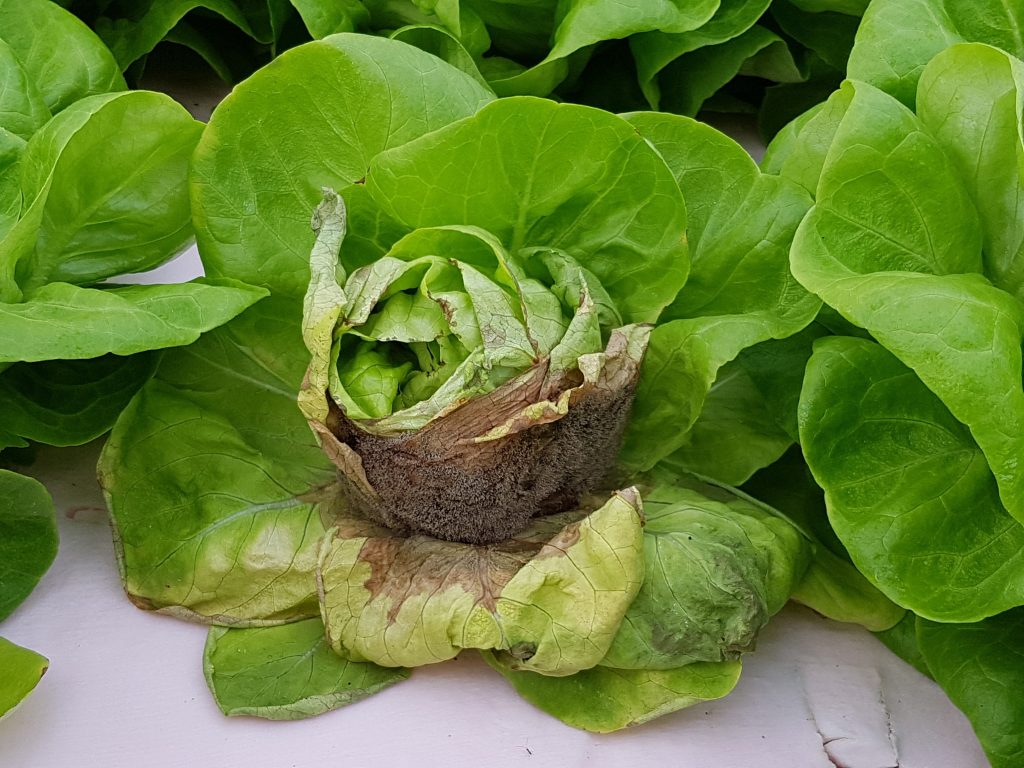
Features
Crops
Vegetables
Managing Botrytis: A serious disease in greenhouse lettuce
August 13, 2019 By Gagandeep Singh Bhatoa & Dr. Mohyuddin Mirza
 Hydroponic lettuce showing fuzzy sporulation of Botrytis with brown discolouration on the leaf margins.
Hydroponic lettuce showing fuzzy sporulation of Botrytis with brown discolouration on the leaf margins. Cloudy and rainy weather during the past months has resulted in many serious outbreaks of Botrytis grey mold in lettuce and in many other crops. This ubiquitous fungus readily attacks lettuce because of the moist, enclosed microclimate created in the lettuce head. If remedial measures are not taken at the first sign of infection, serious crop losses can occur.
Getting to know the fungus
Botrytis cinerea is one of the most devastating and economically important diseases affecting greenhouse lettuce. It is also known as grey mold because it produces abundant fuzzy spores on the surfaces of infected parts. The fungus infects a wide array of greenhouse-grown lettuce, tomatoes, and peppers, as well as some annual and perennial crops. B. cinerea can infect almost all plant parts, especially tender tissues, wounds, and senescent and dead tissues when moisture is available.
Recognize the symptoms
In greenhouses, botrytis can infect the plant right from the seedling stages and can cause damping-off. As the disease progresses, soft brown rot may appear on the stem and at the base of older leaves. Eventually, the plant wilts and dies. Under humid conditions, fuzzy grey to brown discolouration or tan mold (mycelium & spores) can develop on young leaves deep within the head of the lettuce (Fig 1). Sometime initial symptoms of the disease might go unnoticed as they often occur inside dense leaf canopies.
The cycle of disease
In the greenhouse, Botrytis is a fast-growing and aggressive plant killer that overwinters as mycelia or sclerotia in plant debris. Outdoors, it survives as mycelia or sclerotia in soil and plant debris.
Sclerotia are resting structures that serve as a primary source of infection. They germinate to produce sexual fruiting bodies called apothecia, which in turn release ascospores (sexual spores) that initiate infection. However, most of the damage is done by air-borne asexual spores called conidia. Under humid conditions, or once conidia have landed on a wet leaf surface, they germinate and form mycelia which colonize the intercellular spaces within plant tissues through trimming wounds or dying older plants. The mycelia then develop spore-producing structures called conidiophores that produce even more spores, repeating this cycle multiples times during the season.
Spores are not only produced en masse on infected plants, but also survive on plant debris left in greenhouses, as well as in piles of discarded plants outside of the growing area. This repetition of the disease cycle encourages the pathogen to quickly build up disease pressure inside the greenhouse, eventually making it difficult to control this disease.
What can growers do to manage this disease?
Proper climate control is the main strategy for controlling or reducing the severity of grey mold in lettuce and in other crops. Here are some key steps:
Understand the importance of temperature ramping from day to night and from night to day. If the drop from day to night is rapid or the increase is from night to day is rapid, and humidity is high enough, then dew can be formed. That is an “invitation” to Botrytis.
In floating hydroponic systems, water can evaporate from open ponds and create more humidity in greenhouse. Thus, a better dehumidification system is needed.
Pay attention to nutrients that cause rapid vegetative growth, such as the use of high ammonium nitrogen especially during low light periods.
End of crop sanitation is also very critical to managing Botrytis. Clean and sanitize greenhouses regularly. Lettuce is grown as a continuous crop and therefore Botrytis can spread easily from the old crop to the new. Develop a strategy to sanitize the greenhouse once a year during the period when markets may be slower.
Botrytis is a high-risk pathogen, and over the years it has developed multiple resistance to a wide range of chemical fungicides over the years. Repeated use of fungicides with same mode of action have resulted in the development of new pathotypes of Botrytis. Growers must avoid repeated use of same fungicides and should consult local extension specialist for specific fungicides recommended in your region. Also check the product label to make sure that a given fungicide is registered for use in your region. Growers can follow FRAC (Fungicide Resistance Action Committee) codes on modes of action of different fungicides. Rotating applications of different chemistry may help in reducing the risk of resistance.
Growers should use approved biofungicides as preventive measures before the problem arises (rather than curative). As per different research studies, biofungicides like Bacillus subtilis, Trichoderma viride and Streptomyces griseoviridis have been shown to be highly effective against Botrytis.
References
• Smith, T. S. and J.W. Bartok, Jr. 2004. Reduce humidity, Disease in Your Greenhouse. GMPro. November 2004, 52- 58.
• Moorman, G. W. (2011).Botrytis or Gray Mold. Penn State Plant Disease Fact Sheet.
• Asbhee C & Krause MS (2014) Managing Botrytis.www.GreenhouseCanada.com.march 10, 2014.
• Pundt L (2013) The Botrytis battle. Greenhouse Management. November 27,20
Acknowledgements: The authors would like to thank Denny Black, owner of Neva Farms, Manitoba for sharing his practical insights on this disease from a commercial perspective.
Gagandeep Singh Bhatoa is a plant health care specialist in Winnipeg and Mohyuddin Mirza, PhD, is an industry consultant in Edmonton. They can be reached at Gaganagrico@gmail.com and drmirzaconsultants@gmail.com
Print this page
